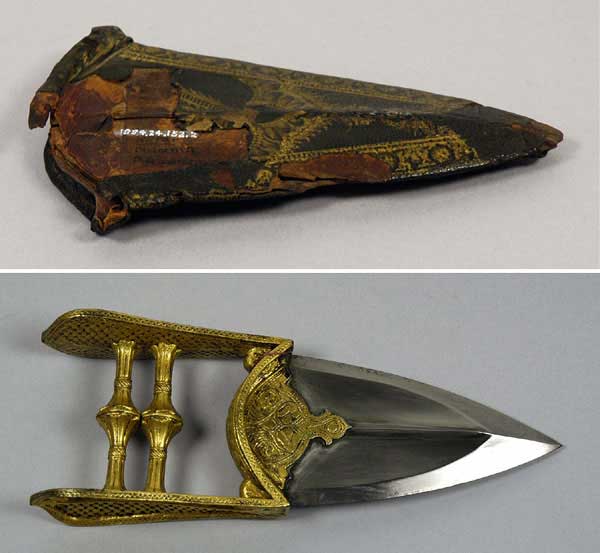File:1884.24.152.jpg
1884.24.152.jpg (600 × 553 pixels, file size: 29 KB, MIME type: image/jpeg)
katar examples
Information This is a katar, an Indian punch weapon. It was developed by the Maratha Empire, a vast Hindu state that covered much of north-central India for 150 years.
A mix of metals and materials was often used in katar manufacture and this example is no exception, with the sheath being of leather-covered wood, painted in gilt designs, and the wrist guards and double bar-grip made of gilded cast brass. The high relief decoration and perforation on this weapon dates it to the 17th or 18th century but the katar was in such widespread use it is impossible to say exactly where in India it might have come from.
Form and Function The katar is unique to India. It is a transverse-handled stabbing dagger, designed to be held with a fist-like grip and the blow delivered with a punching (from high) or poking (from low) action. Its often highly aesthetic appeal, enhanced by an artistically refined blade and pierced and relief decoration, can mask the fact that this is a very functional and effective weapon.
On this katar, the wrist-guards are decorated with a diagonal grid of pierced work but their flaring feather-shape ensures adequate protection for the vulnerable sides of the wrist. The blade is perhaps the most interesting feature of this piece, as it exhibits a central ridge, which widens towards the tip as the blade also dramatically thickens. The result is an armour-piercing, diamond-sectioned point. Seen face-on, this feature is not so noticeable, but is very pronounced when the blade is examined in profile. The transverse grip reflects a more rational and ergonomic approach to designing the handle of a stabbing weapon than the conventional grip of most knives and swords, which is in line with the blade. Clearly, weapons that have this more conventional vertical grip leave the hand exposed as the sides and twist and weaken the wrist when used. The First World War push-knife, used at close-quarters in trench raids, is perhaps the only European example of this discovery.
File history
Click on a date/time to view the file as it appeared at that time.
| Date/Time | Thumbnail | Dimensions | User | Comment | |
|---|---|---|---|---|---|
| current | 04:17, 12 November 2008 |  | 600 × 553 (29 KB) | Linden (talk | contribs) | katar examples Category:Example Images |
- You cannot overwrite this file.
File usage
The following page uses this file: